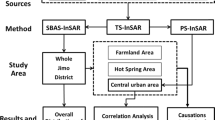Abstract
C- and X-bands Synthetic Aperture Radar (SAR) images acquired from February 2009 to September 2010 were processed with Persistent Scatterer Interferometry (PS-InSAR) algorithm to investigate spatial and temporal variations in deformation over Taiyuan City, China. The spatial pattern of subsidence and the magnitude of subsidence rate are similar in the velocity field maps achieved by the algorithm from these two data sets. It shows that there are four primary subsidence centers in Taiyuan City: Xiayuan, Wujiabao, Xiaodian, Sunjiazhai, which are near the groundwater extraction wells. The maximum subsidence rate is up to 70 mm/year at Sunjiazhai. The locus of maximum subsidence has shifted from its historical location in the north to the south. In view of the severe shortage of water resources and presented features of subsidence over Taiyuan City, we inferred that excessive pumping of groundwater was the dominant reason of land subsidence.
Similar content being viewed by others
References
Shanxi Geological Environment Monitoring Center. Investigation Report of Land Subsidence and Ground Fissure over Shanxi Province, China [EB/OL]. [2013-09-15]. http://www.sxdzhj.com.cn/SXWeb/ReadNews.aspx?ArtID=452.
Yan S L, Guo Q H, Zhou X P. Design of land subsidence monitoring network: A case study at Taiyuan, Shanxi, China [C]//Proceeding of the Seventh International Symposium on Land Subsidence. Shanghai: Shanghai Scientific & Technical Publisher, 2005: 460–465.
Ma T, Wang Y X, Yan S L, et al. Cause of land subsidence in Taiyuan City, Shanxi, China [C]//Proceeding of the Seventh International Symposium on Land Subsidence. Shanghai: Shanghai Scientific & Technical Publisher, 2005: 102–110.
Wu H G, Zhang Y H, Chen X Y, et al. Ground deformation monitoring using small baseline DInSAR technique: A case in Taiyuan City from 2003 to 2009 [J]. Chinese Journal of Geophysics, 2011, 54(3): 673–680(Ch).
Guo Q H. Groundwater System Evolution and Genesis of Relevant Environmental Problems: A Case Study at Taiyuan Basin, Shanxi Province, China [D]. Wuhan: China University of Geosciences, 2005(Ch).
Ferretti A, Prati C, Rocca F. Permanent scatterers in SAR interferometry [J]. IEEE Transactions on Geoscience and Remote Sensing, 2000, 39(1): 8–20.
Ferretti A, Monti G, Prati C, et al. Nonlinear subsidence rate estimation using permanent scatterers in differential SAR [J]. IEEE Transactions on Geoscience and Remote Sensing, 2000, 38(5): 2202–2212.
Ferretti A, Novali F. InSAR permanent scatterer analysis reveals ups and downs in San Francisco Bay Area [J]. Transactions on American Geophysical Union, 2004, 85(34): 317–324.
Colesanti C, Ferretti A, Novali F, et al. SAR monitoring of progressive and seasonal ground deformation using the permanent scatterers technique [J]. IEEE Transactions on Geoscience and Remote Sensing, 2003, 41(7): 1685–1701.
Lyons S, Sandwell D. Fault creep along the southern San Andreas from interferometric synthetic aperture radar, permanent scatterers, and stacking [EB/OL]. [2013-10-11]. http://onlinelibrary.wiley.com/doi/10.1029/2002JB001831/full.
Kampes B. Displacement Parameter Estimation Using Permanent Scatterer Interferometry [D]. Delft: Delft University of Technology, 2005.
Hooper A. Persistent Scatterer Radar Interferometry for Crustal Deformation Studies and Modeling of Volcanic Deformation [D]. Stanford: Stanford University, 2006.
Hooper A, Segall P, Zebker H. Persistent scatterer interferometric synthetic aperture radar for crustal deformation analysis, with application to Volcán Alcedo, Galápagos [EB/OL]. [2013-09-12]. http://onlinelibrary.wiley.com/doi/10.1029/2006JB004763/full.
Hooper A. A multi-temporal InSAR method incorporating both persistent scatterer and small baseline approaches [EB/OL].[2013-10-18]. http://onlinelibrary.wiley.com/doi/10.1029/2008GL034654/full.
Hooper A, Zebker H. Phase unwrapping in three dimensions with application to InSAR time series [J]. Optical Society of America, 2007, 50(9): 2737–2747.
Sousa J, Magalhães M, Ruiz M, et al. The viStaMPS tool for visualization and manipulation of time series interferometric results [J]. Computers & Geosciences, 2013, 52: 409–421.
Sousa J, Hooper A, Hanssen R, et al. Persistent Scatterer InSAR: A comparison of methodologies based on a model of temporal deformation vs. spatial correlation selection criteria [J]. Remote Sensing of Environment, 2011, 115(10): 2652–2663.
Prati C, Ferretti A, Perissin D. Recent advances on surface ground deformation measurement by means of repeated space-borne SAR observations [J]. Journal of Geodynamics, 2010, 49(3): 161–170.
Hooper A, Bekaert D, Spaans K. Recent advances in SAR interferometry time series analysis for measuring crustal deformation [J]. Tectonophysics, 2012, 514: 1–13.
Wang Y, Liao M S, Li D R, et al. Subsidence velocity retrieval from long-term coherent targets in radar interferometric stacks [J]. Chinese Journal of Geophysics, 2007, 50(2): 598–604(Ch).
Berardino P, Fornaro G, Lanari R, et al. A new algorithm for surface deformation monitoring based on small baseline differential SAR interferograms [J]. IEEE Transactions on Geoscience and Remote Sensing, 2002, 40(11): 2375–2383.
Lanari R, Mora O, Manunta M, et al. A Small-Baseline approach for investigating deformations on full-resolution differential SAR interferograms [J]. IEEE Transactions on Geoscience and Remote Sensing, 2004, 42(7): 1377–1386.
Sun Z Y, Ma T, Ma J, et al. Effect of strata heterogeneity on spatial pattern of land subsidence in Taiyuan City [J]. Rock and Soil Mechanics, 2007, 28(2): 399–405(Ch).
Zhang W H. Status of land subsidence and trend of developments of Taiyuan city [J]. Journal of Geological Hazards and Environment Preservation, 2010, 21(4): 38–40(Ch).
Zhu W, Zhang Q, Ding X L, et al. Recent ground deformation of Taiyuan basin (China) investigated with C-, L-, and X-bands SAR images [J]. Journal of Geodynamics, 2013, 70: 28–35.
Geological Survey Institute of Shanxi Province. Investigation Report of Ground-Water Resources and Environmental Problems over Shanxi Province, China [R]. Taiyuan: Geological Survey Institute of Shanxi Province, 2009(Ch).
Author information
Authors and Affiliations
Corresponding author
Additional information
Foundation item: Supported by the National Natural Science Foundation of China(61331016)
Biography: TANG Wei, male, Ph.D. candidate, research direction: satellite radar interferometry for earth surface deformation.
Rights and permissions
About this article
Cite this article
Tang, W., Liao, M. Taiyuan City subsidence observed with Persistent Scatterer InSAR. Wuhan Univ. J. Nat. Sci. 19, 526–534 (2014). https://doi.org/10.1007/s11859-014-1048-7
Received:
Published:
Issue Date:
DOI: https://doi.org/10.1007/s11859-014-1048-7




